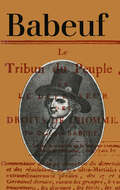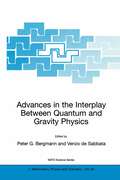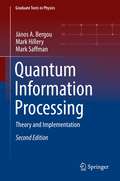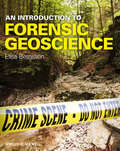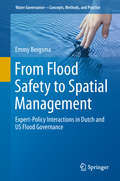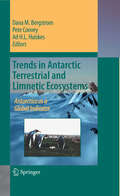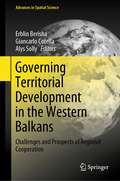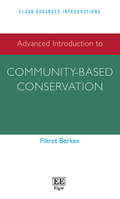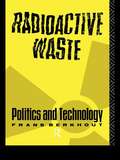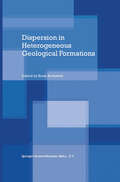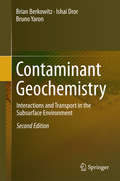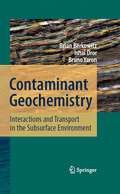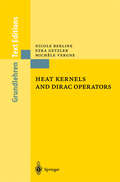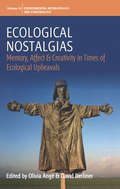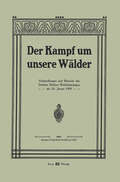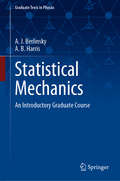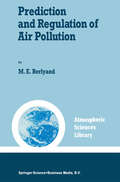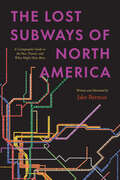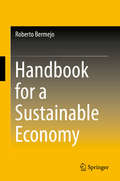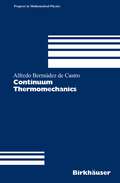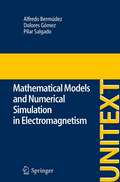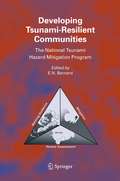- Table View
- List View
Advances in the Interplay Between Quantum and Gravity Physics (NATO Science Series II: Mathematics, Physics and Chemistry #60)
by Peter G. Bergmann V. De SabbataIn this XVII Course of the International School of Cosmology and Gravitation devoted to "ADVANCES IN THE INTERPLAY BETWEEN QUANTUM AND GRAVITY PHYSICS" we have considered different aspects of the influence of gravity on quantum systems. In order to achieve this aim, in many lectures, seminars and discussions we have strengthened the interplay between gravity and quantum systems starting from the situation in the early universe based on astrophysical observations, up to the earthly based experiments with atom interferometry for probing the structure of space-time. Thus we have had timely lectures on the quantum field and horizon of a black hole including reviews of the problem of black holes thermodynamics and entropy, quantum information, quantum black holes, quantum evaporation and Hawking radiation, recent advances in stockastic gravity. We have also discussed quantum fluctuations in inflationary universe, quantum effects and reheating after inflation, and superplanckian energies in Hawking radiation. In this regard the subject of spinors in purely affine space-time and Dirac matter according to Weyl in the generalized theory of gravitation were developed . The dualism between space-time and matter has been deeply analyzed in order to see why, for general relativity, this is an obstacle for quantization of the theory. Also canonical Gravity and Mach's principle, torsion and curvature as commutator for Quantum Gravity and Dirac Geometry of real space-time were analysed, together with the problem of 5-Dimensional Projective Unified Field theory and Multidimensional Gravity and Cosmology.
Quantum Information Processing: Theory and Implementation (Graduate Texts in Physics)
by János A. Bergou Mark Hillery Mark SaffmanThis new edition of a well-received textbook provides a concise introduction to both the theoretical and experimental aspects of quantum information at the graduate level. While the previous edition focused on theory, the book now incorporates discussions of experimental platforms. Several chapters on experimental implementations of quantum information protocols have been added: implementations using neutral atoms, trapped ions, optics, and solidstate systems are each presented in its own chapter. Previous chapters on entanglement, quantum measurements, quantum dynamics, quantum cryptography, and quantum algorithms have been thoroughly updated, and new additions include chapters on the stabilizer formalism and the Gottesman-Knill theorem as well as aspects of classical and quantum information theory. To facilitate learning, each chapter starts with a clear motivation to the topic and closes with exercises and a recommended reading list. Quantum Information Processing: Theory and Implementation will be essential to graduate students studying quantum information as well as and researchers in other areas of physics who wish to gain knowledge in the field.
An Introduction to Forensic Geoscience
by Elisa BergslienAn Introduction to Forensic Geoscience provides fundamental training in geoscience as developed through the lens of its forensic applications. It incorporates a range of topics including geophysical methods of grave detection, the mineralogy of art, identification of microfossils, and comparison of soil trace evidence samples. Each topic is introduced using core concepts that are developed with increasing complexity in order to give readers an understanding of the underlying scientific principles involved and a taste of the wide range of possible forensic uses. A variety of detailed reference tables have been compiled for the text and each chapter contains lists of references to applicable textbooks and journal articles. Examples of real criminal cases are also presented in each chapter to make the connections between theory and real world application. The goal of this book is to give readers a familiarity with the wide range of ways in which geoscience principles and geological materials can be utilized forensically. Additional resources for this book can be found at: http://www.wiley.com/go/bergslien/forensicgeoscience.
An Introduction to Forensic Geoscience
by Elisa BergslienAn Introduction to Forensic Geoscience provides fundamental training in geoscience as developed through the lens of its forensic applications. It incorporates a range of topics including geophysical methods of grave detection, the mineralogy of art, identification of microfossils, and comparison of soil trace evidence samples. Each topic is introduced using core concepts that are developed with increasing complexity in order to give readers an understanding of the underlying scientific principles involved and a taste of the wide range of possible forensic uses. A variety of detailed reference tables have been compiled for the text and each chapter contains lists of references to applicable textbooks and journal articles. Examples of real criminal cases are also presented in each chapter to make the connections between theory and real world application. The goal of this book is to give readers a familiarity with the wide range of ways in which geoscience principles and geological materials can be utilized forensically. Additional resources for this book can be found at: http://www.wiley.com/go/bergslien/forensicgeoscience.
From Flood Safety to Spatial Management: Expert-Policy Interactions in Dutch and US Flood Governance (Water Governance - Concepts, Methods, and Practice)
by Emmy BergsmaThis book deals with the introduction of a new type of “spatial measures" in flood governance. In contrast to traditional “safety measures" that aim to provide protection against floods by building structural flood defenses such as levees and flood walls, the goal of spatial measures is to reduce the exposure to flood risks by changing the spatial layout of flood-prone areas. By limiting developments and flood-proofing buildings in areas at risk to flooding, investments in structural flood defenses can be circumvented and vulnerabilities reduce. World-wide, spatial measures are gaining attractiveness as a response strategy to increasing flood risks caused by climate change and urbanization. The introduction of spatial measures in flood governance involves more than the simple development of new policies and laws. Research has demonstrated that the implementation of spatial measures can have huge implications for how costs and responsibilities are divided between different levels of governance and between public and private actors, changing the whole organization behind flood governance. Both for the effectiveness and for the legitimacy of spatial flood governance strategies, it is important that these distributive implications are well understood. This book describes the introduction of spatial measures in the context of two very different delta countries: the Netherlands and the United States. In the United States, a spatial flood governance strategy was already developed in de mid-20th century whereas in the Netherlands, a safety paradigm institutionalized over the course of the 20th century and spatial measures have only recently been introduced. By analyzing the science-policy interactions underlying the implementation of spatial measures in both countries, this book shows how under the influence of different types of experts (engineers in the Netherlands and social geographers in the United States) different spatial flood management strategies emerged with different distributive implications, each with its own challenges for effectiveness and legitimacy.
Trends in Antarctic Terrestrial and Limnetic Ecosystems: Antarctica as a Global Indicator
by D. M. Bergstrom P. Convey A. H. L. HuiskesThe Antarctic provides a suite of scenarios useful for investigating the range of climate change effects on terrestrial and limnetic biota. The purpose of the book is to provide, based on the most up to date knowledge, a synthesis of the likely effects of climate change on Antarctic terrestrial and limnetic ecosystems and, thereby, to contribute to their management and conservation, based on the information.
Governing Territorial Development in the Western Balkans: Challenges and Prospects of Regional Cooperation (Advances in Spatial Science)
by Erblin Berisha Giancarlo Cotella Alys SollyThis book offers a multifaceted overview of the evolution of spatial development, governance and planning in the Western Balkans from an institutionalist perspective. Written by experts in the field, it features various regional and national studies covering topics such as regional and spatial planning, territorial development and governance, and regional and cross-border cooperation in the Western Balkans. Offering a wealth of national, regional and local insights on territorial cooperation, development and planning, this book will appeal to scholars in regional and spatial sciences and related fields alike.
Advanced Introduction to Community-based Conservation (Elgar Advanced Introductions series)
by Fikret BerkesElgar Advanced Introductions are stimulating and thoughtful introductions to major fields in the social sciences, business and law, expertly written by the world’s leading scholars. Designed to be accessible yet rigorous, they offer concise and lucid surveys of the substantive and policy issues associated with discrete subject areas. Professor Fikret Berkes provides a unique introduction to the social and interdisciplinary dimensions of biodiversity conservation. Examining a range of approaches, new ideas, controversies and debates, he demonstrates that biodiversity loss is not primarily a technical issue, but a social problem that operates in an economic, political and cultural context. Berkes concludes that conservation must be democratized in order to broaden its support base and build more inclusive constituencies for conservation. Key features include: • focus on Indigenous peoples’ rights, knowledge and practices • discussion of commons governance, co-management and responsibility • exploration of the history of conservation and the nature stewardship traditions • a broad view of conservation that encompasses the well-being of humans as well as ecosystems. Taking an interdisciplinary social science approach that includes conservation science concepts, this Advanced Introduction will benefit students of environmental studies, geography, ecology and conservation. It will also be a useful resource for conservation organizations.
Advanced Introduction to Resilience (Elgar Advanced Introductions series)
by Fikret BerkesElgar Advanced Introductions are stimulating and thoughtful introductions to major fields in the social sciences, business and law, expertly written by the world’s leading scholars. Designed to be accessible yet rigorous, they offer concise and lucid surveys of the substantive and policy issues associated with discrete subject areas.Providing a concise overview of resilience in the context of unprecedented global environmental change, this Advanced Introduction addresses the intertwined systems of people and nature. It explores ecological resilience, incorporating social science approaches and concepts, and identifies and discusses innovative ways of planning for an increasingly unpredictable future. Key Features:Identifies practical resilience-building strategies applicable to multiple areasProvides an interdisciplinary discussion of the fundamentals of social and ecological resilienceProposes new ways of dealing with complex environmental problems which present fundamental challenges to conventional science and technologyHighlights knowledge and issues concerning the resilience of Indigenous peoples across the globe, and the lessons that may be learnedExamining the concept of resilience rooted in historical analysis, from Greenland’s Vikings to the collapse of Maya civilization, this insightful Advanced Introduction will be essential reading for students and scholars of environmental studies, ecological economics, environmental and human geography, political studies, socio-economics, sociology and social policy. It includes key concepts for practitioners in the areas of climate change, development studies, disaster management, and natural resources management.
Radioactive Waste: Politics and Technology (The Natural Environment: Problems and Management)
by Frans BerkhoutRadioactive Waste provides a detailed historical account of the policy and practice of radwaste management in Britain, Sweden and the Federal Republic of Germany. In their differing approaches, these three countries define the parameters of civil nuclear strategy in Europe. The comparative analysis of the evolution of policy clarifies the context of political and technical decision-making. Assessing the varying degrees of influence which the public, the industry and the government exercise over these actions, Frans Berkhout applies the concept of boundaries of control', questioning the extent to which such control can be relinquished. This analysis of nuclear strategy, the politics of nuclear power and the shifting emphasis of government regulation redefines the issue of radwaste management and sets it at the centre of the current debate about power, the environment and society.
Radioactive Waste: Politics and Technology (The Natural Environment: Problems and Management)
by Frans BerkhoutRadioactive Waste provides a detailed historical account of the policy and practice of radwaste management in Britain, Sweden and the Federal Republic of Germany. In their differing approaches, these three countries define the parameters of civil nuclear strategy in Europe. The comparative analysis of the evolution of policy clarifies the context of political and technical decision-making. Assessing the varying degrees of influence which the public, the industry and the government exercise over these actions, Frans Berkhout applies the concept of boundaries of control', questioning the extent to which such control can be relinquished. This analysis of nuclear strategy, the politics of nuclear power and the shifting emphasis of government regulation redefines the issue of radwaste management and sets it at the centre of the current debate about power, the environment and society.
Dispersion in Heterogeneous Geological Formations
by Brian BerkowitzIn spite of many years of intensive study, our current abilities to quantify and predict contaminant migration in natural geological formations remain severely limited. The heterogeneity of these formations over a wide range of scales necessitates consideration of sophisticated transport theories. The evolution of such theories has escalated to the point that a review of the subject seems timely. While conceptual and mathematical developments were crucial to the introduction of these new approaches, there are now too many publications that contain theoretical abstractions without regard to real systems, or incremental improvements to existing theories which are known not to be applicable. This volume brings together articles representing a broad spectrum of state-of-the-art approaches for characterization and quantification of contaminant dispersion in heterogeneous porous media. Audience: The contributions are intended to be as accessible as possible to a wide readership of academics and professionals with diverse backgrounds such as earth sciences, subsurface hydrology, petroleum engineering, and soil physics.
Contaminant Geochemistry: Interactions and Transport in the Subsurface Environment
by Brian Berkowitz Ishai Dror Bruno YaronIn this updated and expanded second edition, new literature has been added on contaminant fate in the soil-subsurface environment. In particular, more data on the behavior of inorganic contaminants and on engineered nanomaterials were included, the latter comprising a group of “emerging contaminants” that may reach the soil and subsurface zones.New chapters are devoted to a new perspective of contaminant geochemistry, namely irreversible changes in pristine land and subsurface systems following chemical contamination. Two chapters were added on this topic, focusing attention on the impact of chemical contaminants on the matrix and properties of both liquid and solid phases of soil and subsurface domains. Contaminant impacts on irreversible changes occurring in groundwater are discussed and their irreversible changes on the porous medium solid phase are surveyed. In contrast to the geological time scale controlling natural changes of porous media liquid and solid phases, the time scale associated with chemical pollutant induced changes is far shorter and extends over a “human lifetime scale”.
Contaminant Geochemistry: Interactions and Transport in the Subsurface Environment
by Brian Berkowitz Ishai Dror Bruno YaronCombining earth science, subsurface hydrology and environmental geochemistry, this book provides a comprehensive background for those interested in the protection and sustainable management of the subsurface environment. The reader is introduced to the chemistry of contaminants, which usually disturb the natural equilibrium in the subsurface as a result of human activity. One focus of the book is on contaminant reactions in soil solutions. Discussions on case studies are provided.
Heat Kernels and Dirac Operators (Grundlehren Text Editions)
by Nicole Berline Ezra Getzler Michèle VergneThe first edition of this book presented simple proofs of the Atiyah-Singer Index Theorem for Dirac operators on compact Riemannian manifolds and its generalizations (due to the authors and J.-M. Bismut), using an explicit geometric construction of the heat kernel of a generalized Dirac operator; the new edition makes this popular book available to students and researchers in an attractive softcover. The first four chapters could be used as the text for a graduate course on the applications of linear elliptic operators in differential geometry and the only prerequisites are a familiarity with basic differential geometry. The next four chapters discuss the equivariant index theorem, and include a useful introduction to equivariant differential forms. The last two chapters give a proof, in the spirit of the book, of Bismut's Local Family Index Theorem for Dirac operators.
Ecological Nostalgias: Memory, Affect and Creativity in Times of Ecological Upheavals (Environmental Anthropology and Ethnobiology #26)
by David Berliner Olivia AngéIntroducing the study of econostalgias through a variety of rich ethnographic cases, this volume argues that a strictly human centered approach does not account for contemporary longings triggered by ecosystem upheavals. In this time of climate change, this book explores how nostalgia for fading ecologies unfolds into the interstitial spaces between the biological, the political and the social, regret and hope, the past, the present and the future.
Statistical Mechanics: An Introductory Graduate Course (Graduate Texts in Physics)
by A. J. Berlinsky A. B. HarrisIn a comprehensive treatment of Statistical Mechanics from thermodynamics through the renormalization group, this book serves as the core text for a full-year graduate course in statistical mechanics at either the Masters or Ph.D. level. Each chapter contains numerous exercises, and several chapters treat special topics which can be used as the basis for student projects. The concept of scaling is introduced early and used extensively throughout the text. At the heart of the book is an extensive treatment of mean field theory, from the simplest decoupling approach, through the density matrix formalism, to self-consistent classical and quantum field theory as well as exact solutions on the Cayley tree. Proceeding beyond mean field theory, the book discusses exact mappings involving Potts models, percolation, self-avoiding walks and quenched randomness, connecting various athermal and thermal models. Computational methods such as series expansions and Monte Carlo simulations are discussed, along with exact solutions to the 1D quantum and 2D classical Ising models. The renormalization group formalism is developed, starting from real-space RG and proceeding through a detailed treatment of Wilson’s epsilon expansion. Finally the subject of Kosterlitz-Thouless systems is introduced from a historical perspective and then treated by methods due to Anderson, Kosterlitz, Thouless and Young. Altogether, this comprehensive, up-to-date, and engaging text offers an ideal package for advanced undergraduate or graduate courses or for use in self study.
Prediction and Regulation of Air Pollution (Atmospheric and Oceanographic Sciences Library #14)
by M.E. BerlyandInvestigations of atmospheric pollution have recently reached a new stage. In addition to the estimation and the monitoring of pollutant concentrations in the air around their sources, by way of observational data and also by calcu lations on the basis of theoretical research, it is now possible to make short term forecasts of air pollution and to use them to regulate industrial emissions. Many countries are interested in such forecasts. In the Soviet Union the organizations of the State Committee of the USSR for Hydrometeorology (Goskomgidromet) are carrying out a wide-scale scientific programme on the devising of methods to forecast atmospheric pollution. Prognostic groups are organized in territorial hydrometeocenters; in essence a new forecasting service has been established. Nowadays, in more than 200 towns of the USSR predictions are made and transmitted to large enterprises for the purpose of taking the necessary steps to preserve air qua lity. To ensure an operative working of this service, Methodological Instruc (1979) have been issued, as well as other instructions and guides. Wide tions scale verifications of proposed calculating methods have been made. Prob lems of forecasting and regulating air pollution have become evident lately in other countries as well. Much attention to these problems is payed by the World Meteorological Organization (WMO). They have been widely dis cussed in a number of international conferences and meetings for modelling and investigating pollutant distribution in the atmosphere. The number of publications on this subject is rapidly increasing.
The Lost Subways of North America: A Cartographic Guide to the Past, Present, and What Might Have Been
by Jake BermanA visual exploration of the transit histories of twenty-three US and Canadian cities. Every driver in North America shares one miserable, soul-sucking universal experience—being stuck in traffic. But things weren’t always like this. Why is it that the mass transit systems of most cities in the United States and Canada are now utterly inadequate? The Lost Subways of North America offers a new way to consider this eternal question, with a strikingly visual—and fun—journey through past, present, and unbuilt urban transit. Using meticulous archival research, cartographer and artist Jake Berman has successfully plotted maps of old train networks covering twenty-three North American metropolises, ranging from New York City’s Civil War–era plan for a steam-powered subway under Fifth Avenue to the ultramodern automated Vancouver SkyTrain and the thousand-mile electric railway system of pre–World War II Los Angeles. He takes us through colorful maps of old, often forgotten streetcar lines, lost ideas for never-built transit, and modern rail systems—drawing us into the captivating transit histories of US and Canadian cities. Berman combines vintage styling with modern printing technology to create a sweeping visual history of North American public transit and urban development. With more than one hundred original maps, accompanied by essays on each city’s urban development, this book presents a fascinating look at North American rapid transit systems.
Handbook for a Sustainable Economy
by Roberto BermejoSince the 1992 World Scientists’ Warning to Humanity, the looming prospect of Earth’s changing climate has inspired a broad movement dedicated to a sustainable future. In this Handbook, the author explains the elements of a sustainable economy, the development of which must be undertaken if we are to retain our civilization.The first section offers a critical analysis of orthodox economical thinking, and the tools used by the conventional economy to solve the “environmental problem.” The author examines the theory and tools of Environmental Economics addressing the commodification of nature, and offers analysis of the theoretical and practical contradictions which arise from attempts to combine environmental protection and free trade.Part II discusses the principles and tools needed to build a sustainable economy, including the concept of biomimicry as a guiding principle of sustainability, a brief description of the adaptive cycle of ecosystems and explains the concept of transformability and the factors that determine it. Discussion includes a broad evaluation of the capacity for transformation of National Sustainable Development Strategies and an analysis of the essential requirements of ecology-based tax reform. Also included is a critical vision of the dominant paradigm of science and technology.The third section explores sustainable production and consumption, discussing energy, transport, the circular economy of materials and sustainable consumption. Included are a detailed analysis of factors that determine the limits of fossil fuels, a description of the peak oil structural effect and its sectoral impacts, an overview of a sustainable electric system and a review of biofuels, electricity and hydrogen. The author concludes that only hydrogen associated to fuel offers a sustainable alternative to oil. Discussion includes a view of the structural causes of the current high-level consumption model through the lens of motivation, provision and access systems and a detailed description of policies that must be adopted as part of a sustainable consumption strategy.The final chapter undertakes the task of analyzing the capability of our societies to transform themselves to reach sustainability. The author broadly evaluates each factor, as a prior step to carrying out an overall evaluation and demonstrates that in order to accomplish a comprehensive analysis, a multidisciplinary group is necessary.
Continuum Thermomechanics (Progress in Mathematical Physics #43)
by Alfredo Bermúdez de CastroThe general goal of this book is to deduce rigorously, from the first principles, the partial differential equations governing the thermodynamic processes undergone by continuum media under forces and heat. Solids and fluids are considered in a unified framework. Reacting mixtures of fluids are also included for which general notions of thermodynamics are recalled, such as the Gibbs equilibrium theory. Linear approximate models are mathematically obtained by calculating the derivatives of the constitutive response functions. They include the classical models for linear vibrations of thermoelastic solids and also for wave propagation in fluids (dissipative and non-dissipative acoustics and internal gravity waves).
Mathematical Models and Numerical Simulation in Electromagnetism (UNITEXT #74)
by Alfredo Bermúdez de Castro Dolores Gomez Pilar SalgadoThe book represents a basic support for a master course in electromagnetism oriented to numerical simulation. The main goal of the book is that the reader knows the boundary-value problems of partial differential equations that should be solved in order to perform computer simulation of electromagnetic processes. Moreover it includes a part devoted to electric circuit theory based on ordinary differential equations. The book is mainly oriented to electric engineering applications, going from the general to the specific, namely, from the full Maxwell’s equations to the particular cases of electrostatics, direct current, magnetostatics and eddy currents models. Apart from standard exercises related to analytical calculus, the book includes some others oriented to real-life applications solved with MaxFEM free simulation software.
Developing Tsunami-Resilient Communities: The National Tsunami Hazard Mitigation Program
by E. N. BernardAs the world grieves over the catastrophic loss of humanity from the 26 December 2004 tsunami, we must resolve to learn from nature’s lessons. This issue provides a framework and a set of tools to develop communities that are resilient to tsunami. This collection of papers represents a starting point on our new journey toward a safer world. The history of tsunami hazard mitigation tracks well with the history of destructive tsunamis in the United States. Following the 1946 Alaska g- erated tsunami that killed 173 people in Hawaii, the Paci?c Tsunami Warning Center was established in Hawaii by a predecessor agency to the National Oceanic and Atmospheric Administration (NOAA). Following the 1960 Chilean tsunami that killed 1,000 people in Chile, 61 in Hawaii, and 199 in Japan, the United States formed the Joint Tsunami Research E?ort (JTRE) and sta?ed the International Tsunami Information Center (ITIC) in Hawaii. JTRE was formed to conduct research on tsunamis while ITIC, sponsored by the United Nations, was formed to coordinate tsunami warning e?orts of the Paci?c Countries. Many research and mitigation e?orts were focused on the distant tsunami problem. Following the 1964 Alaskan t- nami that killed 117 in Alaska, 11 in California, and 4 in Oregon, the U. S. was confronted with the local tsunami problem. In response, the U. S. established the Alaska Tsunami Warning Center in Palmer, Alaska. In 1992, a Ms 7.
